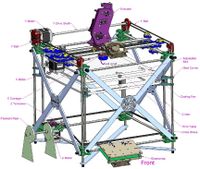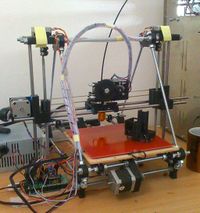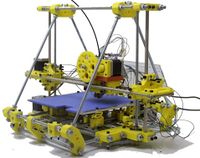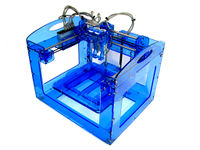3D printer
<pageby nominor="false" comments="false"/>
Introduction

According to Wikipedia, retrieved 14:48, 14 October 2011 (CEST), 3D printing is a form of additive manufacturing technology where a three dimensional object is created by laying down successive layers of material. 3D printers are generally faster, more affordable and easier to use than other additive manufacturing technologies. 3D printers offer product developers the ability to print parts and assemblies made of several materials with different mechanical and physical properties in a single build process. Advanced 3D printing technologies yield models that can serve as product prototypes.}}
See also:
- 3D printers in education and fab lab (for a wider picture)
- RapMan and articles in the RapMan category
- Software (listed below)
3D printing technology
The two most popular 3D printing techniques are:
- fused deposition modeling, also called Fused Filament Fabrication (FFF). A typical example are low cost models like the RapMan
- Selective laser sintering: “an additive manufacturing technique that uses a high power laser (for example, a carbon dioxide laser) to fuse small particles of plastic, metal (direct metal laser sintering), ceramic, or glass powders into a mass that has a desired 3-dimensional shape” (Wikipedia, retrieved 14:48, 14 October 2011 (CEST))
The opposite of additive manufacturing is subtractive manufacturing, e.g. using milling machines that take away material from an initial form. We therefore can present these alternative technologies:
- Laser cutting is a fairly simple to use technique for creating "flat" 3D objects by cutting "sheets" like wood or plexiglass. One can create designs that involve sticking or gluing components together.
- Milling is a process where parts of an object (e.g. a cube) are removed by drilling. For example, parts of car motors are produced like this. Milling is a fairly dangerous process, however hobbyist models that carve out from plastic or wood are safe to use in a classroom for example.
Most 3D printers use an extruder (i.e. a kind of gun) that heats up plastic filament which is then deposited layer by layer. They can print different sorts of Polymers.
- ABS (used for Legos and car parts) is solid, but warps when printed a room temperature. I.e. it is difficult to print objects that have a larger than 4cm footprint.
- PLA (polylactic acid) is made of starch (i.e. plants). It doesn't warp, but it's not very solid and starts deforming (melting) at relatively low temperature.
Syringue-based systems like the Fab@Home can print Epoxy (composites) or food and these materials are pushed down with a piston.
A workflow model
The following figure summarizes typical workflows. There a three fundamental design stages:
- Model an object
- Translate it to format that is appropriate for 3D printing, typically .STL, a stereolithography CAD format created 3D Systems. This file format is supported by many other software packages. STL basically describes an object with slices.
- Translate STL to machine code, typically so-called G-code
As you can see, there are several paths that lead from a design idea to a printed object. Absolute beginners can start simply by downloading STL files from a repository such as Thingiverse, positioning it, maybe resizing and then printing it. Intermediate users can merge existing objects together at any level, e.g. at STL level with a tool like Meshlab (free) or Netfabb (commercial).
Diagrams error (with dot command): Error: /tmp/diagrams_in1d2095fbc89b.dot: syntax error in line 2 near '['
Also take note that respecting physical constraints, e.g. you can't print bigger than your print area, you can't print designs with a large footprint with ABS, you can't print large overhangs with a printer that allows for printing support structures, etc.
Hardware
(This section was revised on oct. 2011. To do: produce some specifications for each model)
Do it (almost) entirely yourself
Reprap 3D printers
RepRap, a British project, is short for Replicating Rapid-prototyper. This type of 3D printer builds the parts up in layers of plastics. It can be assembled from parts bought in various places.
- Introduction to Reprap, retrieved 17:25, 24June 2009 (UTC).
Designs:
- Darwin. The design that inspired current (2010/11) Rapman and CupCake designs
- Mendel Overview (second generation Reprap)
- Prusa Mendel Overview (improved easier to build Mendel)
- Huxley Overview (travel sized mendel)
All RepRap printers can built with spare pars available from many places. However, this requires good "bricolage" skills. For those who don't have these, there exist many commercial kits that are relatively easy to assemble and also fully assembled kits (see below).
Resources:
- RepRap wiki. It includes many resources, like:
- RepRap Official Blog
- RepRap Project (Wikipedia)
- Designs can be shared on thingyverse.
- reprapsource. German company that sells spare parts.
Candyfab printers
Note: As of oct. 2011 this project seems to have stalled (no wiki update since 2009).
Cheap 3D open source printers
“We didn't know it, but it turns out that sitting around a table with folks while the MakerBot Cupcake CNC is puttering away and doing its thing and making objects appear where there were none before is really a great community activity! One of the gatherers mentioned that it felt like a geek campfire and it did!” (Pre Pettis, retrieved 17:30, 25 June 2009)
Below are the fabbers most popular in October 2011, sorted in alphabetical order. All organizations and companies providing designs and selling parts or fully assembled tools do have web sites with a lot of information.
BotMill
Botmill sells 3D Printers that use the (more recent) RepRap Mendel design.
- The Glider 3.0 3D Printer (Fully Assembled) costs $1400 (that's cheap compared to others)
- Print surface: 20.3 x 20.3 x 5.5 cm
- 0.1 mm positioning accuracy, layer thickness = 0.3mm
- The older Axis 2.1 kit costs $1065.
Resources:

Bits from Bytes printers
Bits from Bytes produces and sells Reprap derivatives
Hardware:
- RapMan v3.11 (£750 / CHF 1270) is a device we acquired. We got it in January 2010 and was assembled by end of Feb 2010 Read the RapMan article. - Daniel K. Schneider Nov 2009/Feb 2010.
- Print area: 27 x 20.5 x 21 cm
- Resolution: x&y axis = 0.2mm, z axis = 0.7mm (roughly)
- A1 Technologies is a UK reseller
- Materials: ABS (warping for bottom surfaces larger than 4-5cm), PLA of various sorts.
- The Rapman is one of the first commercial kits for the RepRap v1 and it's probably one of the most beautiful designs. It works well, but does need what we could "RepRap printing skills". Some design elements could be improved, in particular: filament intake (extruder), connectivity (USB instead of a SD card), portability (after transport the structure may need adjustment), (optional) heated platform. The commercial 3D Toutch solves some of these problems.
- 3DTouch 3D Printer is an assembled 3D printer and costs £1,995.00 (single head) or £2,245.00 (double head). We recommend a double head system. The Education pack (£2,484.00) includes double head and plastic rolls. This models seems to be the successor of the BFB 3000 (or the same design ?)
- Resolution: same as RapMan v3.11
Resources:
Fab@Home 3D printers
Fab@Home, is marketed as "personal fabricator". As opposed to RepRap designs, Fab@Home uses a syringe system and can print a large variety of materials, including silicone, cement, stainless steel, cake frosting, and cheese. Hardware designs and software on this website are open source. This printer can include a dual syringe tool for printing two materials simultaneously.
Hardware:
- Fab@Home Version 2.0 - Kit for Single Syringe System costs $2125 (oct. 2011)
- Accuracy: Depends a lot on the materials, with a fine nozzle about 0.1mm in theory (+/- 100 micrometers according to the website).
- An assembled Fab@Home V1.0 - Assembled Two Syringe System would cost $3500
Resources:
Makerbot printers
MakerBot Industries sells other RepRap-inspired designs. Like other Reprap derivaties, their 3D printers include a plastruder and an Arduino-compatible microcontroller and they work with several kinds of plastic, e.g. ABS (Lego-like) and HDPE (milk-jug like). The founder of this company also is involved in the RepRap research project.
Hardware: Currently, (2011) there are three versions:
- A free design called CupCake CNC and and its current (2011) Ultimate. Makerbot will sell the parts. I don't know if there is any difference in design with respect to the Thin-O-Matic kit.
- MakerBot Thing-O-Matic® Kit (formerly called Cupcake?) costs $1300
- Custom Fully Assembled MakerBot Thing-O-Matic® costs $2500.
Other devices are in development as documented in the Makerbot wiki (oct. 2011)
Ultimaker
As of Oct. 2011, the Ultimaker seems to be the favorite open source design kit. It's fast, can print big and it's easy to assemble (compared to a RapMan for example). Ultimaker focuses on speedy PLA printing. PLA doesn't warp like ABS, it is ecological but fragile. ABS is very solid, not ecological and would require a heated bed for larger prints. Therefore, if you need to produce tough objects, Ultimaker may not be a good option.
Hardware:
- Ultimaker Kit (Beta) costs EUR 1200.
- Reprap design
- It can print 21x21x22 cm volumes
- USB connectivity, drivers for Win/Mac and Linux
- 0.4mm nozzle The theoretical resolution: 0.0125 mm for the X and Y axis and better for the Z-axis. Don't know what the practical one would be.
- User-friendly feed mechanism
- No heated bed (?)
Resources:
Commercial entry-level 3D printers
We distinguish between commercial 3D printers that are closed source (below) and commercial open source/open design printers (in the previous section).
Solidoodle
Solidoodle is the first company to offer a fully assembled low-cost (under $1000) printer (Shipping Q4 2011). The box seems to have a closed chamber which is a good solution for printing ABS at a more or less constant temperature.
Hardware:
- The Solidoodle 3D Printer) has an introductory price of $699.
- Design: ReRap Sanguinololu v1.3 electronics
- Max Part size: about 10 x 10 x 10 cm
- Accuracy: .3mm (84dpi)
- .35mm nozzle, using 1.75mm filament (ABS), Sprint loaded extruder (no thumb screws).
Resources:
PP3dp / Up!
- PP3dp sells a light-weight 3D printer for about $2700 + shipping.
- According to the manufacturer the latest model includes a heated platform (good for ABS) and has 0.2 mm accuracy.
- Reviews: Ponoko, ....
Currently (oct. 2011) seems to be the easiest solution (by a large margin) to start printing, i.e. you can unpack and print and don't need to learn about calibration with tools like Skeinforge. On the downside (if I understand right) one only can print ABS in three settings (fine, normal and coarse). Also, the print area is small compared to a RapMan.
Resources:
- Official forum
- 3D Make blog (including "experiments")
Commercial desktop printers
- Desktop Factory 125ci 3D Printer (network compatible, about $5000, 1 cubic inch of "print" costs about $1). See also the Wikipedia entry. No idea, if this product is "real" - Daniel K. Schneider 16:02, 14 October 2011 (CEST).
- CreateItReal (Denmark) will sell a 3D printer for $3000. (planned for 2011, but not available in oct. 2011).
- Matrix 3D printer from Mcor technologies is a Laminated Object Manufacture printer, i.e. glues and cuts paper. You have to buy a package with an annual fee (e.g. £6600)
- uPrint from Dimension / StratSys (about $15000 or the $20000 for the uPrint plus multi-color model). These models use Fused Deposition Modeling with a 0.254mm resolution.
- HP Designjet 3D printer series is a uPrint from StratSys (see above). We don't know if it's totally identical.
- Alaris from Object offers two models. The 93 kg Objet24 Personal 3D Printer and the Objet30 Desktop 3D Printer print at 0.1mm resolution. Both use some kind of polymer jetting technology. Price on request
- 3D Systems sells a ProJet™ 1500 personal 3D color printer for about $/EUR 14500 and the VFlash monocolor for about EUR/$ 10'000. In addition, you have to buy material cartriges.
- The cheapest ZCorp (one of the industry leaders) model, i.e. the ZPrinter 150 is 164 kg and costs about $15'000. The multicolor version, ZPrinter 250, is $25'000.
web services for 3D printing
There exist probably several companies who do this. Typically, online 3D printing services also include a store where users can both upload and sell designs. Some sites also offer other manufacturing and commercial services and most also provide free resources for learning how to create things
Note: The laser cutting and engraving services will be moved once I decide to start resources on that topic.
- They take STL, VRML, Collada & X3D formats with some constraints, e.g. less than 500'000 polygons, a watertight mesh, etc.
- 3D printing and laser cutting.
- Laser cutting service. The company also provides Illustrator, CorelDraw and Inkscape templates
- Laser cutting (very similar or same as Formulor ?)
- Laser Cutting and engraving.
Software
Roughly speaking, the production pipeline looks like this:
- Model something or find a model
- (Merge/adapt models)
- Translate to STL
- Translate to machine code
Relevant EduTechWiki articles
In EduTechWiki, we provide a few overviews and/or beginner's tutorials
- First steps with the RapMan V3.1 3D printer
- OpenScad beginners tutorial (3D modeling with code) and Doblo factory OpenScad routines for creating DUPLO/LEGO clones
- Sketchup 3D printable objects tutorial (3D modeling with this Google tool)
- Sculptris (3D modeling by sculpting)
- Skeinforge for RapMan (G-code generation for the rapman) and G-code (overview)
- Meshlab for RapMan tutorial (translating file formats, mesh merge)
- Netfabb Studio tutorial (positioning, dimensioning of STL files for printing, simple object creation/merge)
3D Software See:
File formats
The most popular file format is the .STL file format: “An STL (“Stereolithography”) file is a triangular representation of a 3-dimensional surface geometry. The surface is tessellated or broken down logically into a series of small triangles (facets). Each facet is described by a perpendicular direction and three points representing the vertices (corners) of the triangle. These data are used by a slicing algorithm to determine the cross sections of the 3-dimensional shape to be built by the fabber” (The StL Format, retrieved 17:25, 24 June 2009 (UTC)). STL files can be created with most CAD programs. Alphaprototypes provides instructions for several popular CAD applications.
Special-purpose software
- ReplicatorG is the software that will drive your CupCake CNC, RepRap machine, or generic CNC machine. You feed it GCode, it parses the GCode, and then controls your machine via a driver. Its cross platform, easily installed, and is based on the familiar Arduino / Processing environments.
- CandyFab developed CandyFaboulous, written in Processing, an open source programming language and environment for people who want to program images, animation, and interaction.
Links
See also the Fab lab article which also includes a bibliography.
Repositories
- New objects (includes visualization and downloadable files)
- 3dprintables.org (excellent wiki includes educational objects, often with links models on external sites)
- Thingiverse (a place to share digital designs that can be made into real, physical objects). Many interesting objects for RepRap machines like the RapMan
- See also "online printing services" (above)
General
- 3D printing directory. (dead link ? on oct 14 2011)
- 3D Printing (Explaining the Future, oct. 2011). Includes a review of both commercial and open source printers.
- Three dimensional printing Laboratory (MIT,last update 2000)
- The next Napster? Copyright questions as 3D printing comes of age by Peter Hanna, ArsTechnica, 2011.
- Fabbaloo is a blog with news about personal manufacturing and 3D printing.
- Planet Reprap - A RepRap blog aggregator
On wikipedia
- 3D printing
- additive manufacturing
- selective laser sintering
- fused deposition modeling
- laminated object manufacturing
Hardware for milling
(to be moved once we create a milling article)
- Roland iModela iM-01 Hobby Mill. Roland also produces other (more powerful) desktop models for milling wood, resin, plaster, etc.
Acknowledgments
- 13:11, 17 October 2011 (CEST). Bart Bekker (Mini FabLab Utrecht) for pointing out two missing items (the Ultimaker and the Solidoodle)







